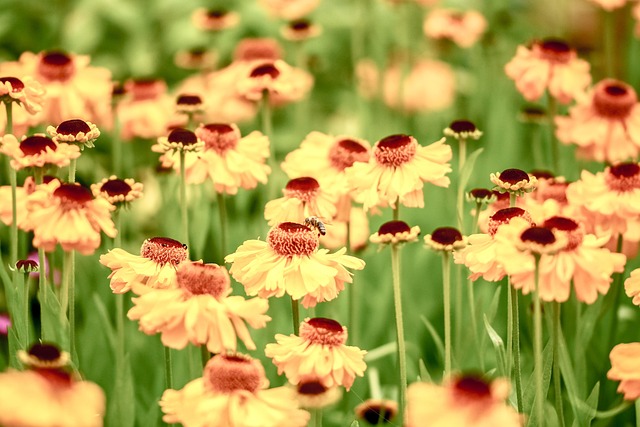Creating a low-maintenance garden involves strategic choices like incorporating drought-tolerant plants, such as lavender, sedum, and yucca, which require less watering. Native plant landscaping, mulching for weed control, and automatic irrigation systems enhance care efficiency. Alternative lawn options include hardscaping ideas like gravel paths and decorative rocks. These techniques collectively promote water conservation while minimizing garden maintenance.
Designing a beautiful yet low-maintenance garden is now more accessible than ever with the right techniques and plant choices. This article guides you through creating a resilient, sustainable space that requires minimal care. Discover the benefits of drought-tolerant plants for water efficiency, explore vibrant perennial flowers that thrive for years, and learn effective mulching techniques to suppress weeds naturally. Additionally, we delve into native plant landscaping and hardscaping ideas, offering practical tips for transforming your outdoor space into an automatic, low-maintenance oasis.
- Choosing Drought-Tolerant Plants for a Resilient Garden
- – Benefits of drought-tolerant plants
- – Popular choices and their care requirements
- – Creating a water-efficient garden design
Choosing Drought-Tolerant Plants for a Resilient Garden

Creating a low-maintenance garden starts with selecting drought-tolerant plants that thrive in challenging conditions. Perennial flowers are an excellent choice for easy care, returning year after year to provide color and interest. Examples include lavender, sedum, and yucca, which not only require less water but also deter pests naturally. Integrating native plant landscaping is another effective strategy as these plants are adapted to local climates, reducing the need for excessive irrigation.
Mulching around plants plays a dual role in low-maintenance gardening. It retains soil moisture, thereby reducing watering needs, and prevents weed growth by blocking sunlight. Consider automatic irrigation systems that can be programmed to deliver water precisely when needed, ensuring your garden stays healthy without constant supervision. For those seeking alternatives to traditional lawns, hardscaping ideas like decorative rocks, gravel paths, and artificial turf offer durable, low-maintenance solutions.
– Benefits of drought-tolerant plants

Designing a garden with drought-tolerant plants offers numerous advantages for gardeners seeking low-maintenance solutions. These plants are specifically adapted to thrive in dry conditions, reducing the need for frequent watering and fostering a more sustainable outdoor space. Perennial flowers, such as lavender, sedum, and yucca, are excellent choices for easy care. They return year after year, requiring minimal upkeep compared to annuals that demand constant attention.
Incorporating native plant landscaping is another effective strategy for creating a low-maintenance garden. Native species are well-suited to local climates and often require less water and maintenance than non-native plants. Mulching around these plants can further enhance their resilience by suppressing weeds, retaining moisture in the soil, and providing insulation during extreme temperatures. Additionally, considering automatic irrigation systems or installing drip irrigation can ensure your garden receives adequate hydration without constant manual intervention. For those seeking alternatives to traditional lawns, low-maintenance grass varieties or even hardscaping ideas like gravel paths and stone patios offer appealing options that require little upkeep.
– Popular choices and their care requirements

Designing a low-maintenance garden doesn’t mean sacrificing beauty or variety; it’s all about choosing plants and features that thrive with minimal care. Popular options include drought-tolerant plants like succulents, cacti, and native grasses, which require little water once established. Perennial flowers for easy care such as daylilies, black-eyed Susans, and coneflowers return year after year, filling your garden with color without annual planting.
Implementing mulching for weed control is another effective strategy. A 2-3 inch layer of organic mulch can prevent weeds from taking root, saving time on weeding. Native plant landscaping not only reduces water needs but also supports local wildlife by providing food and habitat. For those seeking a low-maintenance lawn alternative, consider porous pavers or gravel paths interwoven with hardscaping ideas like decorative stones or low-growing groundcovers. Automate watering with automatic irrigation systems to ensure plants receive adequate moisture without excessive hand-watering.
– Creating a water-efficient garden design

Designing a water-efficient garden goes hand in hand with creating a low-maintenance oasis. One of the most effective strategies is incorporating drought-tolerant plants, such as perennial flowers that require minimal care and watering. These include lavender, sedum, and various succulents known for their ability to thrive with less water. By choosing native plant landscaping options, you can further reduce the need for excessive irrigation while supporting local ecosystems.
Additional tips include implementing mulching techniques for effective weed control, which not only saves time but also reduces competition for moisture. Consider installing automatic irrigation systems that can be programmed to deliver precisely the right amount of water at optimal times, ensuring your garden gets the care it needs without overwatering. For those seeking alternatives to traditional lawns, low-maintenance grass varieties or even hardscaping ideas using stone and paved areas can create visually appealing spaces that demand less upkeep.
By incorporating drought-tolerant plants, efficient water management strategies like mulching and automatic irrigation, and exploring low-maintenance lawn alternatives alongside thoughtful hardscaping, you can create a beautiful, resilient garden that requires less upkeep. Perennial flowers offer easy care and vibrant displays, while native plant landscaping supports local ecosystems. These smart design choices ensure a lush, thriving outdoor space without the constant demand for time-consuming maintenance tasks. Embrace these low-maintenance garden tips to enjoy a serene, sustainable oasis all year round.
